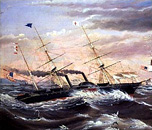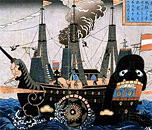
Black Ships & Samurai, Lesson 03
The Black Ships: Multiple Perspectives in
Constructing Historical Narrative
Black Ships & Samurai Handout 03-A | Printer-friendly PDF file
Directions:
The second section of the Black Ships & Samurai Essay, “Black Ships,” opens with side-by-side depictions of a warship in Commodore Matthew Perry’s fleet. The image on the left is an American oil painting, the image on the right a Japanese woodblock print impression.


Each piece of art tells a multi-layered “story” of the American mission to Japan. Presentation of multiple images in a particular way—“placement”—can tell yet another story.
Analyze the story in these two visual texts by answering the questions below.
1. An introductory look at the artwork
A. describe the “tone” or “feeling” of the two artistic depictions of Perry’s ship that open the “Black Ships” section of the Essay. Use at least five adjectives to describe each image and give evidence from the image to support the use of each adjective.
B. Would you describe either image—the American painting on the left or the Japanese woodblock on the right—as “friendly” or “positive”? Give evidence to support your answer.
2. Perry’s ships from an American artist’s perception.
Go to the enlargement of the American painting, “Perry Carrying the ‘Gospel of God’ to the Heathen.”
A. What does this painting portray—that is, describe what is happening in the scene?
Examine the objects and the composition (placement of objects) in this painting. What would you say is the visual subject of this painting?
What is the connection between the visual subject and the title of the painting?
B. List five adjectives you would use to describe the ships in this painting.
List five adjectives you would use to describe the environmental setting (the ocean, sky, etc.) of this painting.
Describe the relationship between the ship and its environment in this painting.
C. Identify three ways that the artist uses lines and angles to convey movement or action in the painting
D.
This piece of artwork presents a picture of a challenge. Who or what is being challenged? Who or what is the challenge?
E.
Identify three ways that the artist conveys adversity and challenge in the painting.
F.
This painting also presents images of power or energy in both the ship and the water. How do you know that water has power? What techniques does the artist use to convey this?
How do you know the ship has power? What techniques does the artist use to convey this?
Do you see any other sources of power? If so, what are they?
G. The title for this painting is “Perry Carrying the ‘Gospel of God’ to the Heathen.” Who are the heathen that the title refers to?
H. In your own words, what is the mission of the Perry expedition, according to the painter of this picture?
I.
Based on your reading of the title, what is America offering Japan? That is, how will Japan benefit from the arrival of Perry?
J. Based on the painting, what does the artist think the United States will find in Japan?
K. Refer back to your notes about the tone of the picture and the challenges conveyed in the painting. Does this painting give the viewer the impression that the Perry mission is an easy one? Provide three pieces of evidence from the painting to support your answer.
3. Perry’s ships from a Japanese perspective
These questions pertain to the woodblock print, “American warship, ca. 1854,” by a Japanese artist on the right side of the opening frame of this section.
A. Analyze this picture in a way similar to the analysis you conducted on the American painting. What does this image portray? That is, what is happening in the picture?
B. List five adjectives you would use to describe the ship in this woodblock print.
List five adjectives you would use to describe the environmental setting (the ocean, sky, etc.) of this painting.
How do the adjectives you listed compare to those you used to describe the ship and water in the American painting? Did you use any of the same words?
C. Look at the objects and the composition or placement of objects in this painting.
How does the composition compare to that of the American painting?
D. What would you say is the subject of this picture—that is, what is the most important image in the picture? How do you know?
E. Do you think this picture also conveys a challenge? If so, who or what is being challenged and who or what is the challenge? How do you know?
F. What differences do you see in the way the black ships are portrayed in these two American and Japanese images?
G. Other than “Black Ships,” what title would you give this woodblock print and why?
Massachusetts Institute of Technology © 2008 Visualizing Cultures
